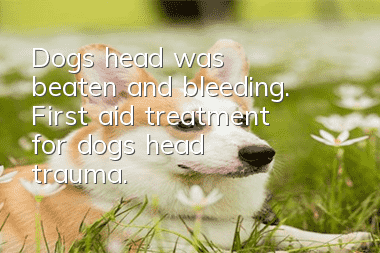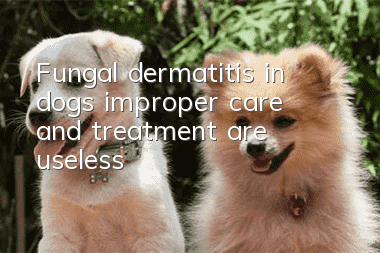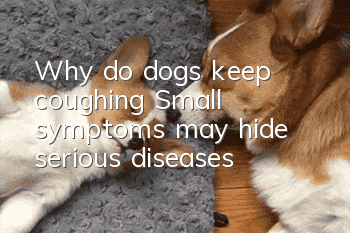Dog's head was beaten and bleeding. First aid treatment for dog's head trauma.

Diagnosis and treatment of bleeding on the head of a dog
During the diagnosis process, observe the dog's mental state, normal movement, wound contamination and foreign matter in the wound. An X-ray is used to check for foreign objects in the brain. After the sick dog was given general anesthesia, the wound was shaved and disinfected with iodine tincture. Use hydrogen peroxide, 0.9% normal saline (250ml), ceftiofur (0.1g), and iodophor to flush the wound site, and use ceftiofur (25mg) and dexamethasone (0.25ml) for continuous subcutaneous injection for seven days, and use A- Parker Anti-Inflammatory Cream for anti-inflammatory treatment. Then subcutaneously inject vitamin K (0.5ml) and ethylamine (1ml) for hemostasis. Finally, intravenously inject 5% glucose sodium chloride injection (250ml), 50% glucose injection (5ml), ATP (0.2ml), coenzyme A (50U unit), gentamicin (0.5ml), and correct water and electrolytes Dissonance.
The wound is mildly infected. After complete debridement, the wound edge is trimmed, sterile surgical suturing is performed, ointment is applied externally, and the wound is disinfected and dressed every day. The stitches will be removed in 7-10 days depending on the healing status.
Measures and principles for the treatment of dog head trauma
Trauma is divided into new injuries and old injuries according to the time after the injury. A new injury occurs a short time after the injury. There is bleeding or blood clots from the wound. The outline of the wound tissue is still discernible. Some wounds are severely infected but have no symptoms of traumatic infection. Old injuries take a long time after injury and the outline of the wound tissue is not easily discernible. Traumatic infection has obvious symptoms, including discharge of pus and granulation tissue. Trauma can be divided into sterile wounds, contaminated wounds and infected wounds according to whether there is infection. Although contaminated wounds are contaminated by bacteria and foreign matter, they do not invade deep tissues for development and reproduction. Infectious wounds become pathogenic bacteria in large numbers and have a pathogenic effect on the body.
Factors that affect wound healing include: wound infection; presence of foreign matter or necrotic tissue in the wound; poor blood circulation in the injured area; restlessness in the injured area; unreasonable wound handling; lack of vitamins in the body;
General principles of trauma treatment
① Anti-shock should be treated first, and then debridement should be performed after the shock improves. However, for massive bleeding, chest wall penetrating wounds and intestinal prolapse, , surgical treatment should be performed while actively fighting shock.
② Prevent and treat infection. Antibiotics should be started immediately after injury to prevent purulent infection, and at the same time, cooperate with local treatment.
③Correction of water and electrolyte imbalance
④ Eliminate factors affecting wound healing
Strengthen feeding management, supplement adequate nutrition, improve resistance, and promote wound healing. For severe wounds, high protein and vitamin-rich feed should be given.
Basic methods of trauma treatment
①Wound cleaning: Cover the wound with sterile gauze, wash with hair-free soapy water around the wound, and disinfect with iodine tincture.
②Wound cleaning: Remove foreign matter, blood clots or pus scab from the wound surface, and repeatedly clean the wound with physiological saline or antiseptic solution until it is clean.
③Debridement surgery: remove all inactivated tissues in the wound, remove visible foreign matter, eliminate the wound sac and concave wall, expand the wound, and ensure smooth drainage.
④Trauma medication can prevent wound infection, accelerate the purification of inflammation, and promote the regeneration of granulation tissue nuclear epithelium.
⑤Trauma suturing
⑥ Trauma drainage When the wound cavity is deep, the wound tract is long, there is necrotic tissue in the wound, or the wound retains exudate, etc., a drainage strip can be used to promote drainage.
⑦ Wound dressing to keep the wound quiet.
⑧Systemic treatment: Use antibiotics to control inflammation and prevent secondary infections.
- What is the reason for severe hair loss in dogs? The root cause of dog hair loss has something to do with you!
- What methods can be used to detoxify a dog after being poisoned? Emergency treatment for different poisoning situations in dogs
- Three common skin diseases in dogs: Keep dogs away from skin diseases
- Is Noble dog food good? Is Noble dog food imported?
- Why do dogs have tear stains and how to reduce tear stains
- Completely correct your dog’s picky eating. This is how to cure your dog’s picky eating.
- Will dog skin diseases relapse after they are cured? Do these things to prevent recurrences
- What kind of dogs eat a lot? Do you know which dogs eat a lot?
- What behaviors should be prohibited for dogs? These prohibited trainings are related to the safety of dogs
- What kind of dog food is good for Pug? Teach you how to choose healthy and good dog food for Pug



